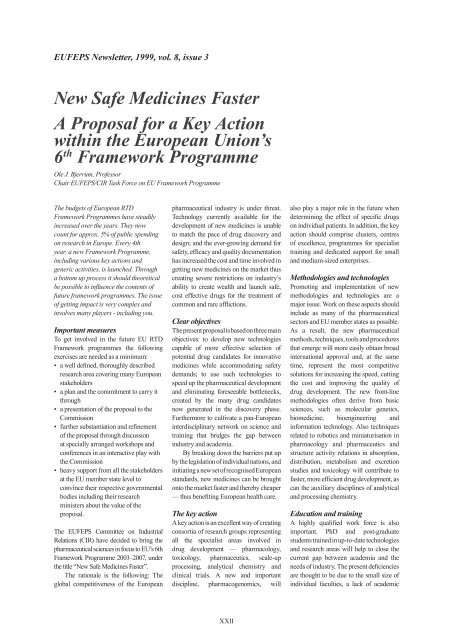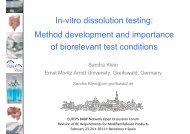2011 Anniversary Yearbook - EUFEPS today and history
2011 Anniversary Yearbook - EUFEPS today and history
2011 Anniversary Yearbook - EUFEPS today and history
You also want an ePaper? Increase the reach of your titles
YUMPU automatically turns print PDFs into web optimized ePapers that Google loves.
<strong>EUFEPS</strong> Newsletter, 1999, vol. 8, issue 3<br />
New Safe Medicines Faster<br />
A Proposal for a Key Action<br />
within the European Union’s<br />
6 th Framework Programme<br />
Ole J. Bjerrum, Professor<br />
Chair <strong>EUFEPS</strong>/CIR Task Force on EU Framework Programme<br />
The budgets of European RTD<br />
Framework Programmes have steadily<br />
increased over the years. They now<br />
count for approx. 5% of public spending<br />
on research in Europe. Every 4th<br />
year, a new Framework Programme,<br />
including various key actions <strong>and</strong><br />
generic activities, is launched. Through<br />
a bottom up process it should theoretical<br />
be possible to influence the contents of<br />
future framework programmes. The issue<br />
of getting impact is very complex <strong>and</strong><br />
involves many players - including you.<br />
Important measures<br />
To get involved in the future EU RTD<br />
Framework programmes the following<br />
exercises are needed as a minimum:<br />
• a well defined, thoroughly described<br />
research area covering many European<br />
stakeholders<br />
• a plan <strong>and</strong> the commitment to carry it<br />
through<br />
• a presentation of the proposal to the<br />
Commission<br />
• further substantiation <strong>and</strong> refinement<br />
of the proposal through discussion<br />
at specially arranged workshops <strong>and</strong><br />
conferences in an interactive play with<br />
the Commission<br />
• heavy support from all the stakeholders<br />
at the EU member state level to<br />
convince their respective governmental<br />
bodies including their research<br />
ministers about the value of the<br />
proposal.<br />
The <strong>EUFEPS</strong> Committee on Industrial<br />
Relations (CIR) have decided to bring the<br />
pharmaceutical sciences in focus to EU’s 6th<br />
Framework Programme 2003–2007, under<br />
the title “New Safe Medicines Faster”.<br />
The rationale is the following: The<br />
global competitiveness of the European<br />
pharmaceutical industry is under threat.<br />
Technology currently available for the<br />
development of new medicines is unable<br />
to match the pace of drug discovery <strong>and</strong><br />
design; <strong>and</strong> the ever-growing dem<strong>and</strong> for<br />
safety, efficacy <strong>and</strong> quality documentation<br />
has increased the cost <strong>and</strong> time involved in<br />
getting new medicines on the market thus<br />
creating severe restrictions on industry’s<br />
ability to create wealth <strong>and</strong> launch safe,<br />
cost effective drugs for the treatment of<br />
common <strong>and</strong> rare afflictions.<br />
Clear objectives<br />
The present proposal is based on three main<br />
objectives: to develop new technologies<br />
capable of more effective selection of<br />
potential drug c<strong>and</strong>idates for innovative<br />
medicines while accommodating safety<br />
dem<strong>and</strong>s; to use such technologies to<br />
speed up the pharmaceutical development<br />
<strong>and</strong> eliminating foreseeable bottlenecks,<br />
created by the many drug c<strong>and</strong>idates<br />
now generated in the discovery phase.<br />
Furthermore to cultivate a pan-European<br />
interdisciplinary network on science <strong>and</strong><br />
training that bridges the gap between<br />
industry <strong>and</strong> academia.<br />
By breaking down the barriers put up<br />
by the legislation of individual nations, <strong>and</strong><br />
initiating a new set of recognised European<br />
st<strong>and</strong>ards, new medicines can be brought<br />
onto the market faster <strong>and</strong> thereby cheaper<br />
— thus benefiting European health care.<br />
The key action<br />
A key action is an excellent way of creating<br />
consortia of research groups representing<br />
all the specialist areas involved in<br />
drug development — pharmacology,<br />
toxicology, pharmaceutics, scale-up<br />
processing, analytical chemistry <strong>and</strong><br />
clinical trials. A new <strong>and</strong> important<br />
discipline, pharmacogenomics, will<br />
XXII<br />
also play a major role in the future when<br />
determining the effect of specific drugs<br />
on individual patients. In addition, the key<br />
action should comprise clusters, centres<br />
of excellence, programmes for specialist<br />
training <strong>and</strong> dedicated support for small<br />
<strong>and</strong> medium-sized enterprises.<br />
Methodologies <strong>and</strong> technologies<br />
Promoting <strong>and</strong> implementation of new<br />
methodologies <strong>and</strong> technologies are a<br />
major issue. Work on these aspects should<br />
include as many of the pharmaceutical<br />
sectors <strong>and</strong> EU member states as possible.<br />
As a result, the new pharmaceutical<br />
methods, techniques, tools <strong>and</strong> procedures<br />
that emerge will more easily obtain broad<br />
international approval <strong>and</strong>, at the same<br />
time, represent the most competitive<br />
solutions for increasing the speed, cutting<br />
the cost <strong>and</strong> improving the quality of<br />
drug development. The new front-line<br />
methodologies often derive from basic<br />
sciences, such as molecular genetics,<br />
biomedicine, bioengineering <strong>and</strong><br />
information technology. Also techniques<br />
related to robotics <strong>and</strong> miniaturisation in<br />
pharmacology <strong>and</strong> pharmaceutics <strong>and</strong><br />
structure activity relations in absorption,<br />
distribution, metabolism <strong>and</strong> excretion<br />
studies <strong>and</strong> toxicology will contribute to<br />
faster, more efficient drug development, as<br />
can the auxiliary disciplines of analytical<br />
<strong>and</strong> processing chemistry.<br />
Education <strong>and</strong> training<br />
A highly qualified work force is also<br />
important. PhD <strong>and</strong> post-graduate<br />
students trained in up-to-date technologies<br />
<strong>and</strong> research areas will help to close the<br />
current gap between academia <strong>and</strong> the<br />
needs of industry. The present deficiencies<br />
are thought to be due to the small size of<br />
individual faculties, a lack of academic




